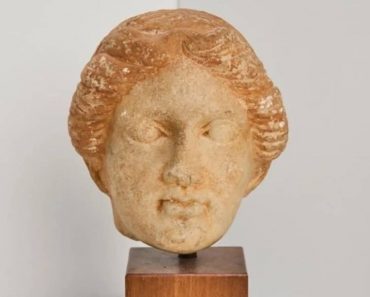
The Cup Bearer, an iconic sculpture of Cycladic art from the period 2800 to 2300 BC, is still puzzling archaeologists. The sculpture (15.2 cm tall) is exhibited at the Museum of Cycladic Art in Athens.
Carved from white Cycladic marble 4,500 years ago, a seated human figure raises a small cup in his right hand. We wonder what he will do. Is he going to drink, make a toast, or pour the contents on the ground in a libation to the gods?
He sits on a stool carved from the same piece of marble and has his legs slightly open while holding his left hand folded across his chest. The surface of the marble is carved smooth, with delicate lines that separate each finger.
Cup Bearer is most likely a male
The Cup Bearer is part of a series of sculptures that include male and female figures playing instruments, sitting in groups, and partaking in various other activities.
Archaeologists admit that as long as there is no written evidence of the people who lived in the Cyclades in the 3rd millennium BC, understanding and interpreting their art will be difficult.
The gender of the figurine is not clear. However, archaeologists believe it belongs to a male figure because it is depicted in action. In Cycladic art, female figures are usually shown standing and not in action in an almost priestly posture with their arms folded under their chests.
In contrast, male figures are shown either seated, as musicians, or as hunters, and only rarely in a standing posture with their arms folded across their chests.
The seated figurine with the cup in his hand differs from most pieces of Cycladic art which are static and flat, much like reliefs.
Cup Bearer resembles modern art
With his entire stance and especially with the free extension of his right arm held away from the body, he seems to conquer three-dimensional space and transforms into a real work of sculpture, a Museum of Cycladic Art representative says.
At the same time, the upward movement of the hand gives a sense of time and continuity that is absent from the other Cycladic figurines, it was added.
If it were a modern work, we would be sure that the artist deliberately froze the movement there to leave his audience wondering what would happen.
During the 1950s to 1960s, looting took place on the Cycladic islands, destroying many of the sacred burial sites and their documents and resulting in the introduction of many “undocumented” replicas of Cycladic sculptures.
There is no signature or “date” inscribed on these sculptures, so it is up to the archaeologist to decipher their history. Having no frame of reference makes it even more difficult to determine what these figures meant to society.
Most of the documents destroyed during the looting can never be recovered—leaving scholars to their own hypotheses and speculations—and adding on to an ever-growing enigma.
Related: Cycladic Art Display at The Met Sends Message on Parthenon Marbles







